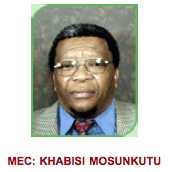Department of Agriculture, Conservation and Environment (05/05/2007)
http://www.gdace.gpg.gov.za/html/Background.htm
THE DEVELOPMENT OF AN ENVIRONMENTAL MANAGEMENT FRAMEWORK FOR THE WESTERN PART OF KUNGWINI LOCAL MUNICIPALITY AREA
1. BACKGROUND
The study area is located within the jurisdiction of the Kungwini
Local Municipality (hereafter referred to as Kungwini), which is
situated towards the north-eastern part of the Gauteng Province.
The western part of Kungwini is currently experiencing high development
pressure, resulting from the eastwards expansion of high income
exclusive housing development and the conversion of small agricultural
holdings into urban uses.
This is manifested by the current urban sprawl towards low-scale
agricultural areas, including Olympus, Shere, Zwavelpoort, Tiegerpoort,
Tweefontein, Rietfontein and Mooiplaats. Consequently, this has
necessitated an integrated approach to environmental planning and
management of the area.
Current land-uses in the area vary from high density Residential 3
development of up to 60 units per hectare on the western border, in the
Olympus and Tweefontein, area to high income residential developments
at low densities of about 10 units per hectare in Silver Lakes,
Rietfontein and Mooikloof and very low densities in the Zwavelpoort,
Tiegerpoort agricultural holdings towards the east.
This eastern region incorporates a large portion of agricultural
holdings predominately used for rural residential purposes and
agricultural activities but with an emerging trend towards resort and
conference facility developments.
The area has many sensitive bio-physical features worth protecting.
These include the Rietvlei dam catchment area which comprises sensitive
underground aquifers and dolomitic geological conditions, sensitive
ecosystems such as Bronberg Ridge and the presence of Red Data fauna
and flora such as the Golden Mole habitat in the Shere area.
Unmanaged and unplanned development could pose a threat to the
integrity of the ecosystem in the area therefore a strategy for better
growth management necessary.
As custodians of the environment, the Gauteng Department of
Agriculture, Conservation, Environment and Land Affairs (GDACEL) is
committed to the protection of ecologically sensitive areas, and to the
promotion of environmentally sensitive development in the Province.
In order to give effect to this commitment GDACEL has undertaken to
establish an Environmental Management Framework (EMF) for the western
Kungwini area.
The EMF would describe the current state of the ecological environment
in the area, establish, through active participation of relevant
stakeholders, the desired state of environment and determine the way
forward from the current status to the desired state.
The major focus of the EMF will be to identify and rank areas of
environmental importance and formulate a framework for making
trade-offs and balancing land-uses.
In addition, the EMF will emphasise the interconnectedness of the
natural ecosystems in the area of study as the framework for
conservation and development.
The aim of this project is to provide an environmental framework that
will support decision-making in order to ensure sustainable development
in the Western section of the Kungwini Local municipality in line with
the principles of the National Environmental Management Act (NEMA)(Act
17 of 1998).
2. DELIVERABLES OF THE PROJECT
• Draft Environmental Status Quo Report
• Environmental Status Quo Report
• Draft Strategic Environmental Management Plan
• Strategic Environmental Management Plan
• Draft Environmental Management Framework
• Environmental Management Framework (EMF)
• Action plan(s) for the implementation of the EMF
This report deals only with the Draft Environmental Status Quo.
3. DELIVERABLES FOR THE DRAFT ENVIRONMENTAL STATUS QUO REPORT
The consultants must, after the necessary review of the literature
and field investigations of the study area, prepare a report on the
status quo of the environment in the study area. This report should
address/include the following:
• Identification of the key environmental issues in the study area;
• A spatial representation of the
environmental status quo.This spatial representation should indicate:
• Sensitive natural environments (such as the ridges and koppies, rivers, red data species)
• Categorisation of areas unsuitable for development due to environmental sensitivity
and the impact on these areas by development thus far
• State of degradation
• Status of services provision/capacity by the Local authority
• Traffic, road infrastructure and network capacity
• State of open space availability/provisions in the area
• Agricultural potential of soils
in the area in line with the Agricultural Resource Act (ARA) and the
Agricultural Potential Atlas
• Land use in the area
A draft of this report must be submitted to the project team for comments prior to finalisation.
This report would also form the basis of consultation to establish the
desired state of environment and develop strategies to be implemented
in order to guide development in the area.
4. SOURCES OF INFORMATION
A number of studies have been for the study area. The detail to
which individual components have been studied varied and varies
considerably: some have been done to great detail and has been accepted
as policy by GDACEL or by the local authority that commissioned the
study. It is not the intention to duplicate the various databases but
rather to use these studies as a basis and supplement it with
additional information.
The studies used for the GIS layers of the status quo are:
SOURCE OF INFORMATION
Bronberg Strategic Environmental Assessment
Gauteng Open Space Project (Version 2 and 3)
Gauteng Agricultural Potential Atlas
The GDACEL Draft Policy for Development on Ridges
The GDACEL Draft Red data Plant Policy
OTHER GOVERNMENT DEPARTMENTS
GAUTRANS road network
Department of Development Planning and Local Government (DPLG): Gauteng
Spatial Development Framework.***** Review Sub-Project 4: Management of
the Urban Edge
DPLG: Gauteng Spatial Development Framework. Phase 3
LOCAL GOVERNMENT
Development Guidelines and frameworks for accommodation at the Rietvlei Nature Reserve
Eastern Gauteng Regional Environmental Framework
Eastern Gauteng Regional Services Council: Water Services Field Manual for the Bronberg Representative Council
The IDP for the Kungwini Local Municipality.

